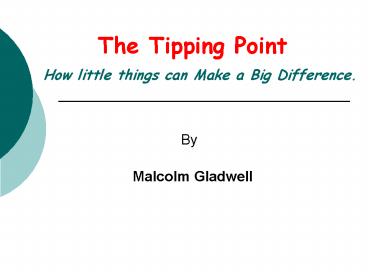The Tipping Point - PowerPoint PPT Presentation
1 / 28
Title:
The Tipping Point
Description:
The author of two international best seller books : The tipping point and The Blink. ... The tipping point looked for the stories like ; ... Tipping points are : ... – PowerPoint PPT presentation
Number of Views:2598
Avg rating:3.0/5.0
Title: The Tipping Point
1
The Tipping Point
- How little things can Make a Big Difference.
By
Malcolm Gladwell
2
Malcolm Gladwell
- He was born in England and graduated from the
University of Toronto, Trinity College, with a
degree in history. - Malcolm Gladwell has been a staff writer with The
New Yorker magazine since 1996. - The author of two international best seller books
The tipping point and The Blink. - in 2005 he was named one of Time Magazine's 100
Most Influential People.
3
The Author Malcolm Gladwell
4
The Characteristics
- Little things can have big effect
- Contagiousness (Big or Mass)
- One Dramatic Moment (The change happens not
gradually)
5
The tipping point characteristics
Effect
Time
6
Rules of Epidemic
is a function of the people who transmit
infection agent in appropriated environment
CARRIER
Agent
Appropriated Environment
7
Social Epidemic
- ???
8
(No Transcript)
9
(No Transcript)
10
The Three Rules of Contagious
The Law of the few
The Stickiness
The Power of The Context
11
The Law of the Few
- 80/20 Principle a tiny percentage of people do
the majority of the work. - A handful of exceptional people
12
Paul Revere and his midnight ride
- April 18, 1775
- Lead to American Revolution
- He was members of as many groups.
- He was a networker and so on (59).
A Connector
13
The Hush Puppies Famous
- 1994-1995
- The classic brush-suede shoes became popular.
- A handful of kids then spread to two Fashion
designers.
A Connector
14
Mark Alpert and his Mavenist
- He knows things that the rest of us dont.
- He solves his own problems his own emotion
needs by solving other peoples problem. - A wonderful unselfish man.
- He is a Market
Maven
15
The Studies of Persuasion
- The bias of newscasters to America president
election. - The persuasion for raising the university
tuition.
16
What makes Persuasion so effective.
- Little things can make as much of a difference as
big things. - Non-verbal cues are as or more important than
verbal cues. (78-79) - Persuasion often works in ways that we do not
appreciate.
Saleman
17
The Law of the Few
- Connector Know many kinds of Peopleand a lot
of people. - Maven One who accumulate knowledge, Unselfish
and Not persuader - Saleman Persuader
18
The Stickiness
- Quality (92-93)
- So Cool
- Memorable -gt a message makes an impact.
- Create change -gt Spark someone to act.
19
The Stickiness
- Sesame street, Blues Clue Show.
- The Tetanus fear experiment.
20
The power of the context
- Bernie Goetz a symbol of a dark moment in New
York History. - 1980 The rise and fall of New York crime ,2000
murders and 600,000 /a year. - Epidemic of violence.
21
The power of the context
- You can prevent crimes just by scrubbing off
graffiti and arresting fare-beater. - The broken window theory.
22
The power of Context (Part Two)
- The Magic Number (One hundred and fifty)
- Ya-Ya sisterhood became the best seller book.
- Gore Associates based in Delware. Try to get
under 150 limit. If over it sets up a new plant.
23
Case study Rumors, Sneaker, and The power of
translation
- Airwalk 1997.
- The spread of hybrid seed corn in Green country,
IOWA, 1930-1938 - How to spread a new idea.
- 3 groups The innovator -gt early adopter -gt the
early majority
24
Case study Suicide
- Epidemic Suicide Among Micronesian adolescents
- 1980s,There were more suicides per capita in
Micronesia than anywhere in the world.(217) - Suicide lead to suicide.
25
Case study The teen smoking epidemic illustrate
the stickiness.
- Two possibilities for against the smoking
epidemic. - 1986s,The correlation between smoking and
depression or emotional problem.(244-245) - The addiction threshold (4-6 mg. of nicotine). ?
un-sticky cigarette
26
Conclusion Focus, test and believe
- The tipping point looked for the stories like
(small but smart) - Sadler worked on prevention of DM and breast
cancer. - Start epidemics requires concentrating (Focus) on
a few key. - Reframe the way we think about the world
27
Conclusion Focus, test and believe
- Those who are successful at creating epidemics do
not just do what they think is right but they
test their intuitions. - What must underlies successful epidemics is a
bedrock belivf that change is possible.
28
Conclusion
- Tipping points are
- a reaffirmation of the potential for change
and the power of intelligent action.































